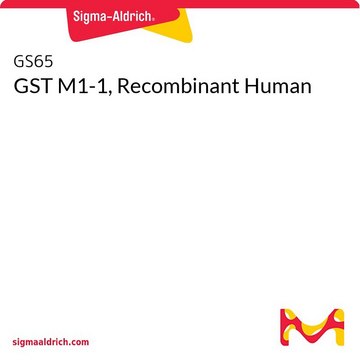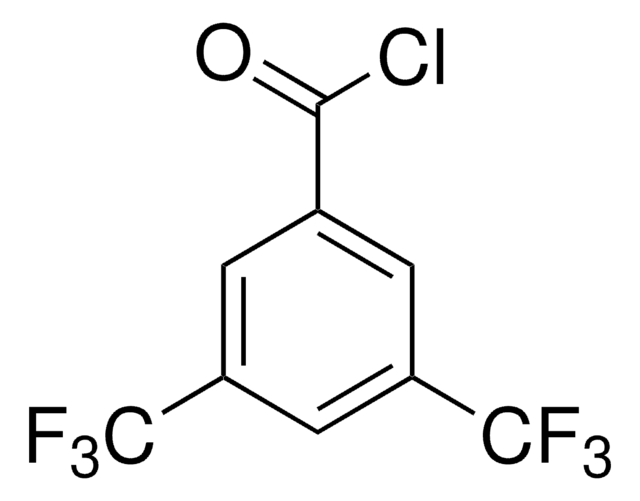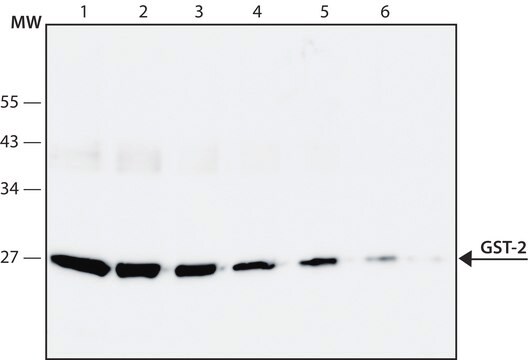GS90
GST T1-1, Recombinant Human
Synonyme(s) :
glutathione S-transferase theta 1
Se connecterpour consulter vos tarifs contractuels et ceux de votre entreprise/organisme
About This Item
Code UNSPSC :
12352200
Nomenclature NACRES :
NA.26
Produits recommandés
Source biologique
human
Niveau de qualité
Produit recombinant
expressed in E. coli
Pureté
95% (SDS-PAGE)
Forme
frozen liquid
Activité spécifique
8.8 units/mg protein
Poids mol.
25 kDa
Concentration
1.95 mg/mL
Température de stockage
−70°C
Informations sur le gène
human ... GSTT1(2952)
Description générale
Glutathione S-transferase theta 1 (GSTT1) and GSTT2/GSTT2B share 55% amino acid sequence identity and may play a role in human carcinogenesis. The GSTT1 gene is haplotype-specific and is absent from 38% of the population. Alternative splicing of this gene results in multiple transcript variants.GSTT1 is an enzyme that in humans is encoded by the GSTT1 gene. The GSTT1 gene contains five exons and four introns and spans 8092bp on genomic DNA. It is mapped to human chromosome 22q11.23. This gene codes for a 240 amino acids, which is mainly expressed in human liver. Based on their biochemical, immunologic, and structural properties, cytosolic and membrane-bound forms of glutathione S-transferase are encoded by two distinct supergene families. At present, eight distinct classes of the soluble cytoplasmic mammalian glutathione S-transferases have been identified: α, κ, μ, ω, π, σ, θ and ζ.
as assayed by the spectrophotometric determination of NADPH oxidation coupled to the glutathione peroxidase activity of GST T1-1 on cumene hydroperoxide (1.5 mM) in the presence of reduced glutathione (1 mM) in 100 mM NaPO4 (pH 7.0) at room temperature.
Actions biochimiques/physiologiques
Glutathione S-transferase theta 1 (GSTT1) is an enzyme that in humans is encoded by the GSTT1 gene. Glutathione S-transferases (GSTs) are a family of enzymes that play an important role in detoxification by catalyzing the conjugation of many hydrophobic and electrophilic compounds with reduced glutathione. Mutation in the gene might lead to the development of lung, head and neck cancer. The GSTs are thought to function in xenobiotic metabolism and play a role in susceptibility to cancer, and other diseases.
Stockage et stabilité
The enzyme should be used by the end-user customer within 1 year of receipt.
Code de la classe de stockage
10 - Combustible liquids
Classe de danger pour l'eau (WGK)
WGK 1
Point d'éclair (°F)
Not applicable
Point d'éclair (°C)
Not applicable
Certificats d'analyse (COA)
Recherchez un Certificats d'analyse (COA) en saisissant le numéro de lot du produit. Les numéros de lot figurent sur l'étiquette du produit après les mots "Lot" ou "Batch".
Déjà en possession de ce produit ?
Retrouvez la documentation relative aux produits que vous avez récemment achetés dans la Bibliothèque de documents.
Wen Sun et al.
BMC ophthalmology, 15, 84-84 (2015-07-26)
Glutathione S transferase (GST) polymorphisms have been considered as risk factors for age-related cataracts, but the results remain controversial. In this study, we have performed a meta-analysis to evaluate the association between polymorphisms of GSTM1 and GSTT1 and cataract risk.
Ender Coskunpinar et al.
Asian Pacific journal of cancer prevention : APJCP, 15(5), 2319-2321 (2014-04-11)
Our aim was to determine GSTT1 expression levels in left colon tumors and paired normal tissue in order to identify specific alterations in GSTT1 mRNA levels. Alterations in GSTT1 expression in twenty-four left- sided colon tumors and paired cancer free
Bacterial glutathione S-transferases: what are they good for?
Vuilleumier, S, et al.
Journal of Bacteriology, 179, 1431-1431 (1997)
Alfredo Santovito et al.
Journal of biochemical and molecular toxicology, 29(5), 234-239 (2015-02-04)
Occupational exposure to anaesthetic gases is one of the major hazards to healthcare personnel. We evaluated the cytogenetic effects of chronic exposure to low concentrations of anaesthetic gases in operating theatres. The study included 21 anesthetists and 21 control subjects
Glutathione and glutathione-dependent enzymes represent a co-ordinately regulated defence against oxidative stress
Hayes, J. D, et al.
Free Radical Research, 31, 273-300 (1999)
Notre équipe de scientifiques dispose d'une expérience dans tous les secteurs de la recherche, notamment en sciences de la vie, science des matériaux, synthèse chimique, chromatographie, analyse et dans de nombreux autres domaines..
Contacter notre Service technique



![[1,1′-bis(diphénylphosphino)ferrocène]dichloropalladium(II)](/deepweb/assets/sigmaaldrich/product/structures/130/734/8846aa26-1858-458a-998d-8c306c13bf0f/640/8846aa26-1858-458a-998d-8c306c13bf0f.png)




